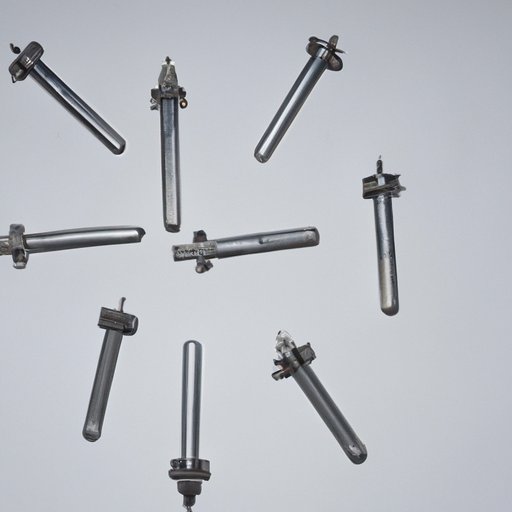
Introduction
Have you ever tried to hang a picture or a shelf on a wall, only to have it come crashing down moments later? Almost everyone has experienced this frustration, and the solution is simple: wall anchors.
This article is a step-by-step guide for beginners who want to learn how to use wall anchors. From selecting the right anchor to drilling the pilot hole to setting the anchor in place, we’ll take you through the entire process. Additionally, we’ll provide tips and tricks, a video tutorial, a product review, safety precautions, and a list of FAQ’s.
Step-by-Step Guide
The first step in using wall anchors is choosing the right type. Consider the weight of the object you want to hang, as well as the surface of the wall. There are many types of wall anchors available, including plastic, metal, and toggle anchors. Plastic anchors are suitable for lightweight objects, while metal anchors are ideal for heavier objects. Toggle anchors are designed for use in drywall, plaster, and similar materials.
Once you’ve selected the right anchor type, follow these steps:
- Determine the best location for the anchor. Use a stud finder to locate the studs in the wall, or tap on the wall to find a solid spot.
- Mark the location where the anchor will be inserted.
- Drill a pilot hole using a drill bit that’s slightly smaller than the anchor. Be sure to use a drill that’s appropriate for the type of wall you’re working with (e.g., a masonry bit for concrete walls).
- Insert the anchor into the pilot hole. If the anchor is a toggle type, follow the manufacturer’s instructions for opening the wings.
- Screw in the screw until it’s snug but not over-tightened. Over-tightening can cause the anchor to break or the wall to crack.
Tips and Tricks
Here are some tips and tricks to help you use wall anchors more effectively:
- Choose the right size anchor for the weight of the object.
- If you’re not sure which size anchor to use, opt for a larger size. You can always drill a bigger pilot hole if necessary.
- If you’re working with a hollow wall, such as drywall or plasterboard, make sure to use a wall anchor that’s suitable for the weight of the object.
- When drilling pilot holes, use a piece of tape over the drill bit to measure the depth of the hole.
- If you’re drilling into a tile wall, use a carbide-tipped masonry bit and go slowly. Use a low speed on your drill and avoid applying too much pressure.
Video Tutorial
For those who prefer a visual demonstration, we’ve found a video tutorial that provides step-by-step instructions for using wall anchors.
The video tutorial can be used in conjunction with the written guide to provide a comprehensive learning experience.
Product Review
There are many types of wall anchors available, so we’ve compiled a list of some of the best ones to help you choose:
- Plastic anchors: These are great for lightweight objects such as pictures and small shelves. They’re easy to install and come in a variety of sizes. Some examples include the TOGGLER Plastic Toggle Anchor and The Hillman Group Ribbed Plastic Anchor.
- Metal anchors: These are designed for heavier objects and are suitable for use in concrete, brick, and plaster walls. Some examples include the T.K.Excellent Zinc Plated Self-Drilling Drywall Anchors and the Qualihome Hollow Wall Anchor Set.
- Toggle anchors: These are ideal for use in drywall, plaster, and similar materials. Some examples include the SNAPTOGGLE Heavy Duty Toggle Bolt and The Hillman Group Toggle Bolt.
Each type of wall anchor has its pros and cons, so it’s important to consider your specific needs before making a purchase.
Safety Precautions
Wall anchor installation involves drilling and handling tools, so it’s important to take safety precautions to avoid injury. Here are some tips:
- Use protective gear, such as safety goggles and gloves.
- Handle tools safely and follow the manufacturer’s instructions.
- Avoid electrical hazards by turning off the power before drilling into walls that may contain electrical wiring.
FAQ’s
Here are some common questions about wall anchors:
- What weight can each wall anchor support? It depends on the type of anchor. Refer to the manufacturer’s recommendations for weight limits.
- Which surfaces are compatible with which types of anchors? Refer to the manufacturer’s recommendations for surfaces that are compatible with each type of anchor. Generally, plastic anchors are suitable for drywall and plaster, while metal anchors are suitable for concrete and brick walls.
- How to remove wall anchors without damaging walls? Use pliers or a screwdriver to remove the screw, then gently tap the anchor into the wall with a hammer until it’s flush with the wall. If the anchor won’t budge, use a pair of pliers to twist it while pulling it out of the wall.
Conclusion
Using wall anchors may seem intimidating at first, but with the right tools and knowledge, anyone can do it. By following our step-by-step guide, you can confidently install wall anchors for all your DIY projects. Remember to choose the right anchor type and size, follow safety precautions, and refer to our tips and tricks for help along the way.





